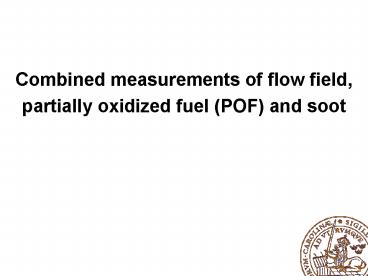Combined measurements of flow field, - PowerPoint PPT Presentation
1 / 25
Title:
Combined measurements of flow field,
Description:
Strong correlation between regions of high soot luminosity and positive vorticity ... Vorticity. In-cylinder quantitative. soot measurements. Soot history ... – PowerPoint PPT presentation
Number of Views:32
Avg rating:3.0/5.0
Title: Combined measurements of flow field,
1
- Combined measurements of flow field,
- partially oxidized fuel (POF) and soot
2
Combined PIV, LII and LIF of PPC motivation
- Numerical simulations suggest
- bulk flow structures can
- enhance late-cycle mixing rates
Can we observe these structures experimentally?
Simulation performed at University of Wisconsin
for previous work with Paul Miles.
Unburned fuel and air are transported to a common
interface at higher swirl
3
Operating condition
Engine Volvo D5 Speed 1200 RPM Load 4.0
bar O2 12 (56 EGR) ? 1.15 CA50 5
ATDC SOI -12.5 ATDC Fuel 70 n-heptane 30
iso-octane
Smoke (FSN)
4
Ignition
Little evidence of POF despite turn-up in AHRR
First low-temp heat release occurs in lower
central bowl Fuel from head of jet?
5
Start of high temperature heat release
Earlier POF transported upward, inward
Diminished POF suggests initial high-temp HR
occurs in upper bowl
Volume expansion identifies main heat release
asoccurring in upper, outer bowl
Volume expansion near edges of POF
6
Late pre-mixed burning
- Soot first appears after the peak heat release
- Soot POF appear in two distinct spatial zones
- A dual-vortex flow structure is observed, but,
contrary to simulations of similar engines, the
inner vortex contains POF!
7
Later mixing-controlled burning
POF above piston top remains spatially
fixed Flow structure in central region is
dominated by axial expansion. This means that
there is little flow motion to promote mixing of
this fluid Heat release remains concentrated
within the bowl, giving the reverse squish flow a
strong vertical component, leading to formation
of a toroidal vortex above the piston top
8
Late-cycle burnout
9
Single-cycle images / flow fields (not
simultaneous)
10
Soot, POF in-cylinder history
11
Summary and conclusions I
- Dual-vortex flow structures similar to those
observed in numerical simulations are observed.
Heat release at the interface of the two vortices
remains to be verified/quantified (more
accurate/precise measurements are needed).The
presence of POF within these structures needs to
be evaluated carefully experimental POF
distributionsappear to contradict numerical
predictions. - Dual-zone distributions of POF are observed
during the expansion stroke. The dual zone
distribution is also observed on a single-cycle
basis. Soot, however, is found mainly within the
central zone.
12
Summary and conclusions II
- Mean bulk flow structures during expansion do
little to mix fluid within the central zone with
fluid elsewhere in the cylinder. - POF in the outer zone, above the bowl mouth, is
located (trapped?) within a toroidal vortex
attached to the piston top. - Single-cycle flow fields and POF/soot
distributions retain many features observed in
the mean fields.
13
- Comparison of the flow fields of
- conventional and late injection timings
- as well as different swirl ratios
14
Operating conditions
- Late timing (below)
- O2 15 (40 EGR)
- SOI - 4.0 ATDC
- CA50 18 ATDC
Conventional timing (above) O2 12 (56
EGR) SOI - 12.5 ATDC CA50 5 ATDC
15
Fuel jet setting up vortex
Late injection SOI -4
- Conventional injection timing
- SOI -12.5
Fuel jet sets up a standing vortex, clearly
visible before main heat release Peak velocities
around 4 Sp
16
Mixing-controlled combustion conv. timing
- Vortex formed at centreline moves
- outwards
- imparts looping motion on reverse-squish flow
- fluid entering squish region comes from uppermost
regions of the cylinder
17
Late mixing controlled burn conv. timing
- Vortex formed in centre still present, now at
bowl mouth - Second vortex formed at centreline
- Upward looping reverse-squish motion still present
18
Premixed combustion, late timing
- Some flow directed into squish volume apparent at
10 CAD - Reverse-squish motion stronger than for
conventional injection timing - Transport into squish volume mainly from mid-part
of bowl for conv. timing mostly from outer
parts
19
Mixing-controlled combustion late timing
- Mushroom-shaped structure formed
- transports fluid both inwards and outwards
- Evolves into looping motion at rim, forms full
vortex
20
Influence of swirl
- Late timing
- Higher swirl
Late timing Lower swirl
Main difference is the fluid motion entering the
squish region. At higher swirl, this motion has a
dominant vertical component and evolves into a
toroidal vortex by 30 CAD. At lower swirl, fluid
trajectory is much flatter and the formation of
the toroidal vortex is delayed until about 35-40
CAD.
21
Summary and conclusions
- Fuel injection event sets up a clockwise-rotating
vortex in the bowl region. Peak velocities in
this flow are up to about 4 times the mean piston
speed. - Peak reverse squish flow is found to coincide
closely with the timing of the peak heat release - For the higher swirl cases, the location of the
peak maximum in the reverse squish flow are
different for the two operating conditions - Conventional timing has maximum close to bowl rim
- Later timing has maximum closer to bowl
mid-radius - Toroidal vortex appears near bowl rim just after
start of mixing-controlled combustion - Looping structure at bowl rim is flatter at lower
swirl andthe formation of toroidal vortex is
delayed
22
- Investigation of combustion with EGR
- using high speed video
23
(Very) preliminary observations
- Strong correlation between regions of high soot
luminosity and positive vorticity - Work in progress
- Results and conclusions will beadded when
available
24
- In-cylinder quantitative
- soot measurements
25
Soot history
Same later-cycle soot amount, but very different
in-cylinder soot history at different (high) EGR
ratios. Most soot production takes place after
peak of heat release































